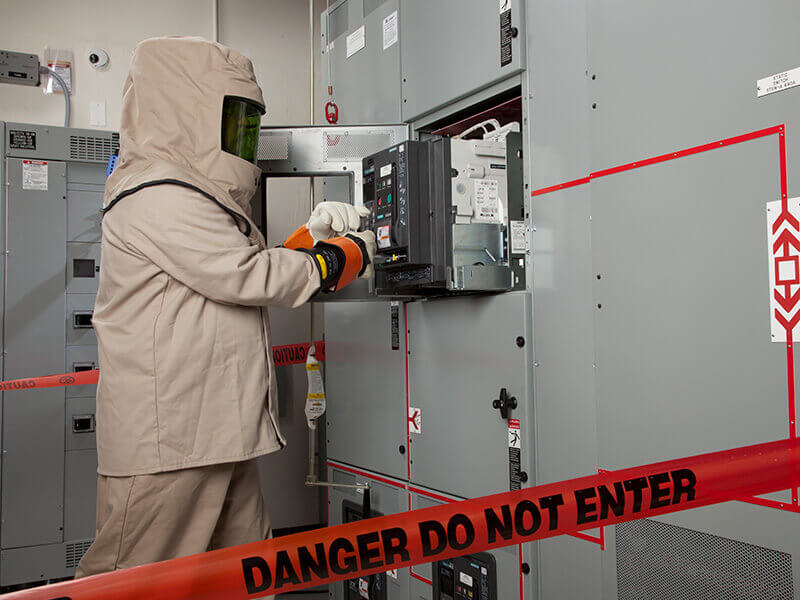Arcing from an electrical fault can produce temperatures hotter than the surface of the sun, creating a blast with force similar to an explosion—enough to throw a worker’s body across the room. According to the National Safety Council, electrical hazards such as arc flash are responsible for one worker fatality every workday.

Due to the devastating consequences of arc flash, the National Fire Protection Association (NFPA) continues to update NFPA 70E: Standard for Electrical Safety in the Workplace®. Recent changes deal specifically with how facilities assess arc flash risks and determine the appropriate personal protective equipment (PPE) for employees working on or near energized electrical equipment.
The standard provides two options for determining the arc flash boundary distance and PPE requirements: the table method and the engineering analysis method. Although either option could be used, provisions in the newest version of 70E clearly indicate that the engineering analysis method has broader applicability.
The Problem with the Table Method
NFPA 70E 2015 includes task-based tables that can be used to determine when arc flash risks exist and what PPE should be used. While the table method “costs nothing” to use and is arguably easier to implement than an engineering analysis, the table method can easily be misused in the field, putting workers at risk.
To help simplify the table method, NFPA 70E introduced a new multi-table format in the 2015 version of the standard. To use the new tables:
- Workers first look to Table 130.7(C)(15)(A)(a) to determine if an arc flash hazard exists for the task they are performing. This task-based table covers both AC and DC applications and indicates if there is an arc flash hazard associated with each specific task—yes or no
- If there is an arc flash hazard, workers move to Table 130.7(C)(15)(A)(b) or 130.7(C)(15)(B) to find the arc flash PPE category
- Lastly, workers refer to Table 130.7(C)(16), which lists the clothing and other PPE required for the specific task they need to perform
Even though the table method has been improved, in many cases, it is still impractical to use. Workers rarely have access to the system parameters—available fault current values and fault clearing times—that are required to use the tables correctly. And while the tables provide guidelines for common tasks, workers may need to perform tasks that are not specifically included in the tables. For those reasons, NFPA 70E 2015 makes it clear that the table method may only be used if:
- The specific task to be performed appears in the tables.
- The system meets the listed criteria for short circuit current magnitude and speed of response of circuit protection.
In all other cases, an engineering analysis must be performed.
The Advantages of Engineering Analysis
NFPA 70E 2015 Article 130.5(C)(1) recommends performing an engineering analysis using one of the recognized means such as Institute of Electrical and Electronic Engineers’ Guide for Performing Arc Flash Calculations (IEEE 1584). When incident energy is determined in this way, the results of the analysis can be used to create site-specific arc flash protection and PPE requirements.
In facilities that use the engineering analysis method:
- The results of the analysis are printed on the equipment label in the form of incident energy (in calories per square centimeter at working distance).
- Workers are then able to choose PPE with an Arc Thermal Performance Value (ATPV) that meets or exceeds the available incident energy posted on the informational label. ATPV is also rated in calories per square centimeter to make this determination simple.
While engineering analysis requires more upfront work, it ultimately makes it easier for workers to protect themselves. Analysis ensures the most appropriate PPE for the hazard. Since using more PPE than required becomes cumbersome and could actually be detrimental to worker safety, engineering analysis helps ensure the optimal level of protection.
How a Professional Electrical Engineering or Electrical Testing Service Provider Can Help
With the ever-expanding scope of arc flash protection and the clear advantages of using the engineering analysis method over the table method when determining arc flash risk, many facilities find it difficult to comply with the latest electrical safety standards. And while there is no legal requirement for a registered professional engineer to perform arc flash hazard analysis, such an expert can provide invaluable assistance.
Professional electrical engineering and electrical testing firms can offer state-of-the-art software along with knowledge of current regulations. The right partner helps ensure that data is collected, reviewed, and interpreted properly, and that incident energy calculations are accurate. Such expertise not only helps improve compliance, it can help facilities better protect their people and even save lives.






